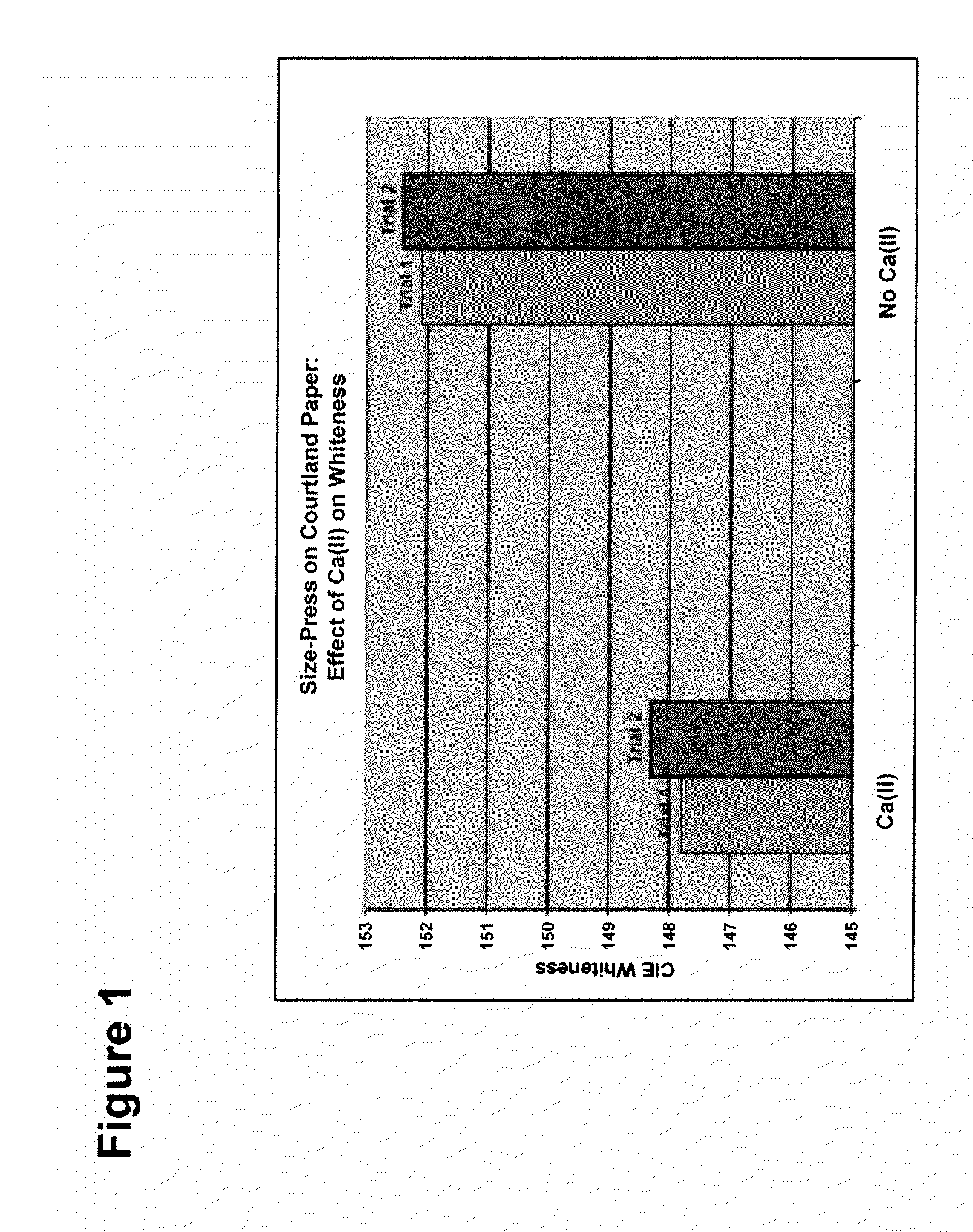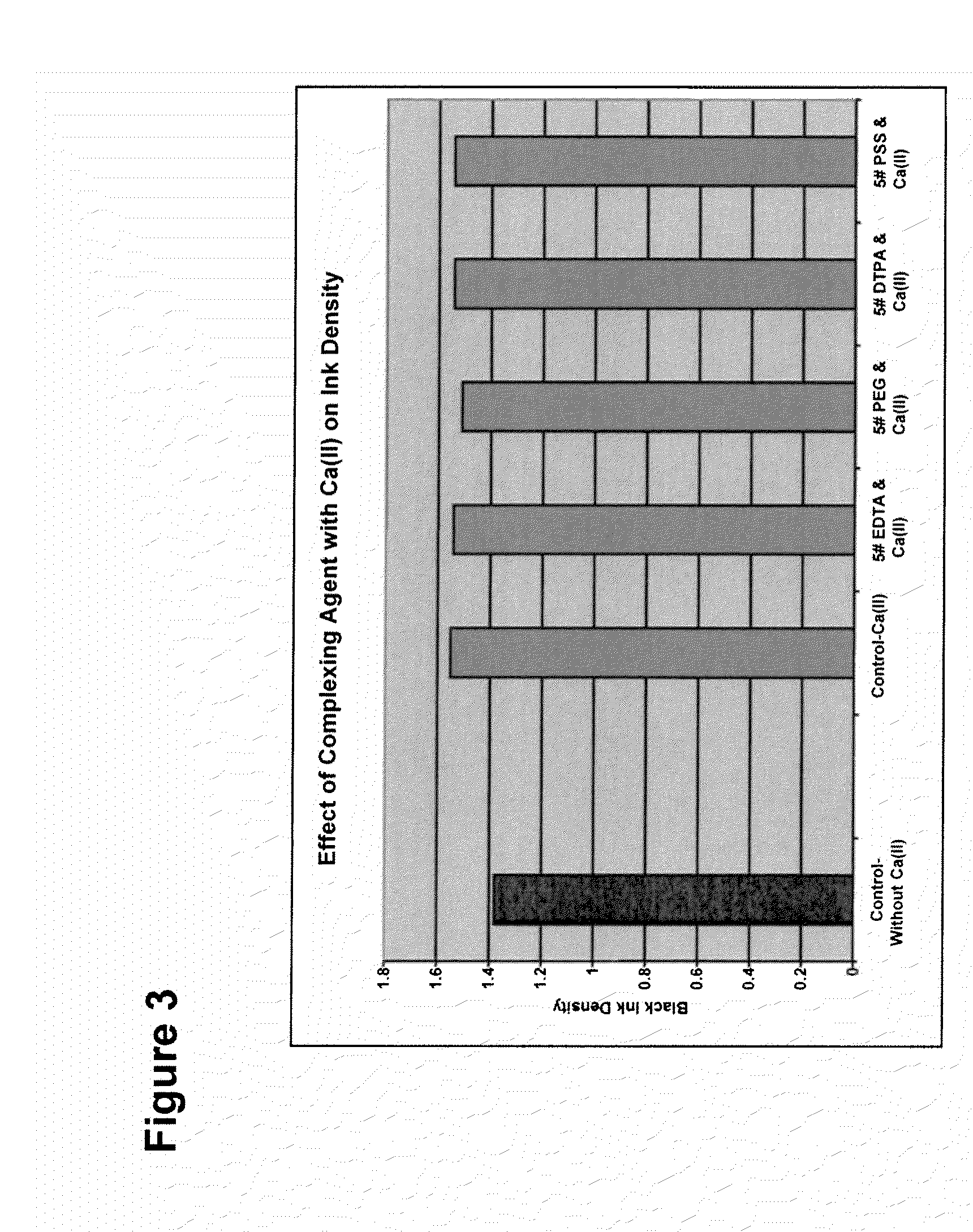Composition and recording sheet with improved optical properties
a technology of optical properties and recording sheets, applied in the field of compositions for papermaking, can solve the problems of reducing brightness and whiteness, increasing the use of obates, and increasing product costs, so as to improve optical properties, improve optical properties, and improve optical properties
- Summary
- Abstract
- Description
- Claims
- Application Information
AI Technical Summary
Benefits of technology
Problems solved by technology
Method used
Image
Examples
example 1
Ca(II) Decreases OBA Optical Properties
[0204]A lab-scale puddle size press was used for the treatment on a Mill A produced base paper. The size press formulation was conventionally represented on the basis of each 100 lb of starch. In this experiment, 40 Lb of OBA (Clariant Leucophor BCW) was used per 100 Lb of cooked ethylated starch (Penford Gum 280, cooked at 18% solids). In one case, 15 Lb of CaCl2 was added. In another case, no Ca(II) was used.
[0205]FIG. 1 and the tables below show the effect of Ca(II) on CIE whiteness. It is quite clear, with these two runs (repeated a few days apart), that the presence of Ca(II) significantly decreased the paper optical properties.
Bench-top size-press, 40 Lb OBA per 100 Lb of ethylated starch.brightnesswhitenessNo Ca(II)94.2152.1With Ca(II)93.9147.8
Another run, at 40 # of OBA per 100 lb of ethylated starch.whitenessNo Ca(II)152.4With Ca(II)148.3
example 2
Impact of Complexing Agents on CIE Whiteness
[0206]A lab-scale size press treatment was conducted, similar to Example 1. In the formulation, 40 Lb of OBA (Leucophore BCW) and 5 Lb of complexing agents were used per 100 Lb of ethylated starch. In one case, 15 Lb of CaCl2 was added in the formulation. In another case, no CaCl2 was added.
[0207]The results (as shown in the following tables and graphically in FIG. 2) indicate that complexing agents may improve whiteness of paper. Especially in the presence of Ca(II), EDTA complexes with Ca(II) improves whiteness, while EDTA with no Ca(II) does not show a beneficial effect.
With Ca(II)BrightnessWhitenessCa(II) Control93.9147.85# EDTA in Ca(II)93.8149.35# PEG in Ca(II)93.9149.45# DTPA in Ca(II)93.8149.35# PSS in Ca(II)93.7148.9
Without Ca(II)BrightnessWhitenessControl-without Ca(II)94.5152.05# EDTA without Ca(II)93.0142.55# PEG without Ca(II)94.2152.55# DTPA without Ca(II)94.5153.45# PSS without Ca(II)94.5152.9
example 3
Complexing Agents with Ca(II) on Ink-Jet Printing Properties
[0208]Soluble Ca(II) is known to improve ink-jet printing properties, such as ink density. In this experiment, treated paper samples as in Example 2 were tested for printing properties. It is shown clearly that adding complex agents with Ca(II) did not negatively impact the printing properties. The results are illustrated in the following table and graphically in FIG. 3 and FIG. 4.
Ink Density% Ink-transfer / removalControl-without Ca(II)1.3826.6%Ca(II) Control1.5523.2%5# EDTA in Ca(II)1.5419.1%5# PEG in Ca(II)1.5113.7%5# DTPA in Ca(II)1.54 19%5# PSS in Ca(II)1.54 11%
PUM
| Property | Measurement | Unit |
|---|---|---|
| pH | aaaaa | aaaaa |
| pH | aaaaa | aaaaa |
| lengths | aaaaa | aaaaa |
Abstract
Description
Claims
Application Information
 Login to View More
Login to View More - R&D
- Intellectual Property
- Life Sciences
- Materials
- Tech Scout
- Unparalleled Data Quality
- Higher Quality Content
- 60% Fewer Hallucinations
Browse by: Latest US Patents, China's latest patents, Technical Efficacy Thesaurus, Application Domain, Technology Topic, Popular Technical Reports.
© 2025 PatSnap. All rights reserved.Legal|Privacy policy|Modern Slavery Act Transparency Statement|Sitemap|About US| Contact US: help@patsnap.com



